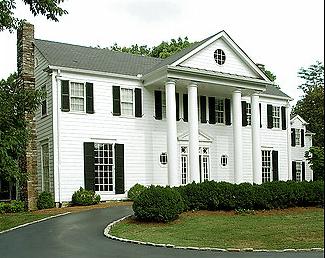Origin
A 2007 report from the Tennessee Center for Policy Research (TCPR), claiming that Al Gore's Tennessee home uses over 20 times more energy than the average U.S. home, was released the day after the former vice-president's film about global warming, An Inconvenient Truth, won an Academy Award for Best Documentary:
Al Gore's Personal Energy Use Is His Own "Inconvenient Truth"
Gore's home uses more than 20 times the national average
Last night, Al Gore's global-warming documentary, An Inconvenient Truth, collected an Oscar for best documentary feature, but the Tennessee
Center for Policy Research has found that Gore deserves a gold statue for hypocrisy.
Gore's mansion, located in the posh Belle Meade area of Nashville, consumes more electricity every month than the average American household uses in an entire year, according to the Nashville Electric
Service (NES).In his documentary, the former Vice President calls on Americans to conserve energy by reducing electricity consumption at home.
The average household in America consumes 10,656 kilowatt-hours (kWh) per year, according to the Department of Energy. In 2006, Gore devoured nearly 221,000 kWh - more than 20 times the national average.
Last August alone, Gore burned through 22,619 kWh-guzzling more than twice the electricity in one month than an average American family uses in an entire year. As a result of his energy consumption, Gore's average monthly electric bill topped $1,359.
Since the release of An Inconvenient Truth, Gore's energy consumption has increased from an average of 16,200 kWh per month in 2005, to 18,400 kWh per month in 2006.
Gore's extravagant energy use does not stop at his electric bill. Natural gas bills for Gore's mansion and guest house averaged $1,080 per month last year.
"As the spokesman of choice for the global warming movement, Al Gore has to be willing to walk to walk, not just talk the talk, when it comes to home energy use," said Tennessee Center for Policy Research
President Drew Johnson.In total, Gore paid nearly $30,000 in combined electricity and natural gas bills for his Nashville estate in 2006.

The specific numbers involved were disputable (the TCPR claimed Gore's home used electricity at a rate more than "20 times the national average," while the Associated Press reported that their own review of bills indicated that the Gores' Nashville household used more than 12 times the average for a typical household in that area), but the basic gist of the claim — that the Gores' Nashville residence consumed a larger proportion of energy than the average American home — was true.
Some important points not covered in the report, however, included whether equating the Gores' home to the average American home was really a relevant comparison. A spokesperson for the Gore family responded by noting some mitigating factors, such as the fact that the Gores' Nashville residence isn't an "average" house: it's about four times larger than the average new American home built in 2006, and it essentially functions as both a residence and a business office since both Al and Tipper work out of their home. The Tennessean also noted that the Gores had been paying a $432 per month premium on their monthly electricity bills in order to obtain some of their electricity from "green" sources (i.e., solar or other renewable energy sources). Other factors (such as the climate in the area where the home is located and its size) made the Gore home's energy usage comparable to that of other homes in the same area.
The former vice-president maintained that comparing raw energy-usage figures was misleading and that he leads what he advocates, a "carbon-neutral lifestyle," by purchasing energy from renewable energy sources such as solar, wind and methane gas to balance out the carbon emissions produced in generating the electricity his home used:
Kalee Kreider, a spokesperson for the Gores, pointed out that both Al and Tipper Gore work out of their home and she argued that "the bottom line is that every family has a different carbon footprint. And what Vice President Gore has asked is for families to calculate that footprint and take steps to reduce and offset it."
A carbon footprint is a calculation of the CO2 fossil fuel emissions each person is responsible for, either directly because of his or her transportation and energy consumption or indirectly because of the manufacture and eventual breakdown of products he or she uses.
The vice president has done that, Kreider argues, and the family tries to offset that carbon footprint by purchasing their power through the local Green Power Switch program — electricity generated through renewable resources such as solar, wind, and methane gas, which create less waste and pollution. "In addition, they are in the midst of installing solar panels on their home, which will enable them to use less power," Kreider added. "They also use compact fluorescent bulbs and other energy efficiency measures and then they purchase offsets for their carbon emissions to bring their carbon footprint down to zero."
Also, by the end of 2007 the Gores had completed renovations that made their home much more energy-efficient:
Al Gore, who was criticized for high electric bills at his Tennessee mansion, has completed a host of improvements to make the home more energy efficient, and a building-industry group has praised the house as one of the nation's most environmentally friendly.
The former vice president has installed solar panels, a rainwater-collection system and geothermal heating. He also replaced all incandescent lights with compact fluorescent or light-emitting diode bulbs.
"Short of tearing it down and staring anew, I don't know how it could have been rated any higher," said Kim Shinn of the U.S. Green Building Council, which gave the house its second-highest rating for sustainable design.
Gore's improvements cut the home's summer electrical consumption by 11 percent compared with a year ago, according to utility records reviewed by The Associated Press. Most Nashville homes used 20 percent to 30 percent more electricity during the same period because of a record heat wave.
Nearly identical claims were published in August 2017 — after the release of An Inconvenient Sequel: Truth to Power, Gore's follow-up to his Oscar-winning 2006 documentary — this time under the misleading headline “Al Gore’s Home Devours 34 Times More Electricity Than Average U.S. Household.”
Drew Johnson, a senior fellow at the National Center for Public Policy Research, a conservative think tank, wrote the August 2017 piece. (Johnson appears to have been behind the 2007 claims about Gore's energy use as well.) In that article, he cited his own report for National Center for Public Policy Research (without making it clear that he authored the report), in which he found that Gore’s electricity bill for September 2016 was 34 times more than the national average. However, Johnson, as well as other sources that replicated his claims — including the National Center for Public Policy Research’s own press release — implied in the headlines or bodies of their articles that Gore’s home "consistently devoured” 34 times more energy than the average home, which was not the case: that figure was based on estimates for a single month during the previous year, and that single month was August, a time of the year when energy usage typically spikes due high mid-summer temperatures.
When we asked about the discrepancy in the headline of his article ("“Al Gore’s Home Devours 34 Times More Electricity Than Average U.S. Household"), Johnson told us (emphasis ours):
The title I turned in to the Daily Caller for the column/op-ed was "Al Gore’s Home Devours Up to 34 Times More Electricity than an Average U.S. Household, Hypocritically Issues Call to Reduce Energy Consumption in New Film.” My goal was to indicate that, at its highest, Gore's home energy usage spikes to 34X that of the typical American household (as the NCPPR paper suggests). It is not accurate that Gore's home consistently uses 34X the national average — in the past year, Gore's home consumed 21.35X the national average. I even rounded down to 21.3X in everything I wrote to be as fair and as bulletproof as possible — that's why I went about so thoroughly discussing the makeup of the power he receives at his home and his donations to the Green Power Switch program, so there would be no confusion on those issues when it came to his power bill costs and his "100% renewable" claim.”
I don't believe the DC title intentionally misrepresented the report. I just gave an unwieldy title that needed to be trimmed down. And although I wish there was a qualifier ("up to", "as much as", "in one month"), it was based off of a legitimate number.
(We have reached out to Nashville Electric Service and Al Gore’s media team to confirm the numbers but have yet to receive a response.)
If one were to compare electricity consumption in Al Gore's home in April (the month of lowest usage) to the national average, the multiplier drops from 34 to 10. Of course, comparing any single month to an annual average is problematic, as monthly electric use fluctuates throughout the year (and also in response to local conditions, such as weather and climate patterns).

